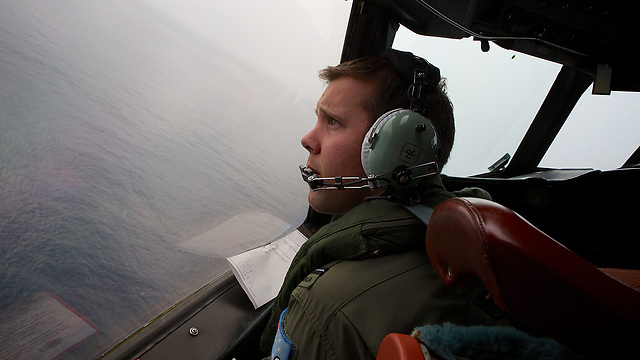
After over two weeks of an international search effort, Malaysia Airlines has announced that it was safe to assume "beyond any reasonable doubt" that the plane that disappeared earlier this month has been lost, and that none of the 239 people on board survived.
In a briefing to the families of those aboard the plane on Monday, Malaysian Prime Minister Najib Razak said a new analysis of satellite data shows that the missing Malaysia Airlines plane plunged into the southern Indian Ocean.
Flight MH370 vanished from civilian radar screens less than an hour after taking off from Kuala Lumpur for Beijing with on March 8. No confirmed sighting of the plane has been made since and there is no clue what went wrong.
Attention and resources in the search for the Boeing 777 have shifted from an initial focus north of the Equator to an increasingly narrowed stretch of rough sea in the southern Indian Ocean, thousands of miles from the original flight path.
An Australian navy ship was searching for possible debris from the plane earlier on Monday as a mounting number of sightings of floating objects raised hopes wreckage of the plane may soon be found.
The HMAS Success should reach two objects spotted by Australian military aircraft by Tuesday morning at the latest, Malaysia's government said, offering the first chance of picking up suspected debris from the plane.
Related stories:
- Australia reports possible debris from Malaysian plane in Indian Ocean
- Lost passenger jet was diverted deliberately, says Malaysian leader
- US investigators suspect missing Malaysian plane flew for hours
So far, ships in the international search effort have been unable to locate several "suspicious" objects spotted by satellites in grainy images or by fast-flying aircraft over a vast search area in the remote southern Indian Ocean.
"HMAS Success is on scene and is attempting to locate and recover these objects," Australian Prime Minister Tony Abbott, who called his Malaysia counterpart Najib Razak to inform him of the sighting, said in a statement to parliament.
The objects, described as a "grey or green circular object" and an "orange rectangular object", were spotted about 2,500 km west of Perth on Monday afternoon, said Abbott, adding that three planes were also en route to the area.
Neither Malaysia nor Australia gave details on the objects' size.
"We're not sure if Success will be able to find them tonight," John Young, general manager of the emergency response division of the Australian Maritime Safety Authority, said in a video statement. "She may need the assistance of another serch aircraft on the scene tomorrow to do that."
Earlier Monday, Xinhua news agency said a Chinese Ilyushin IL-76 aircraft spotted two "relatively big" floating objects and several smaller white ones dispersed over several kilometres.
Beijing responded cautiously to the find. "At present, we cannot yet confirm that the floating objects are connected with the missing plane," Foreign Ministry spokesman Hong Lei told a news briefing in Beijing.
Australia said that a US Navy plane searching the area on Monday had been unable to locate the objects.
China has diverted its icebreaker Xuelong, or Snow Dragon, toward the location where the debris was spotted. A flotilla of other Chinese ships are also steadily making their way south. The ships will start to arrive in the area on Tuesday.
Over 150 of the passengers on board the missing plane were Chinese.
The latest sighting followed reports by an Australian crew over the weekend of a floating wooden pallet and strapping belts in an area of the icy southern Indian Ocean that was identified after satellites recorded images of potential debris.
In a further sign the search may be bearing fruit, the US Navy is flying in its high-tech black box detector to the area.
The so-called black boxes - the cockpit voice recorder and flight data recorder - record what happens on board planes in flight. At crash sites, finding the black boxes soon is crucial because the locator beacons they carry fade out after 30 days.
"If debris is found we will be able to respond as quickly as possible since the battery life of the black box's pinger is limited," Commander Chris Budde, US Seventh Fleet Operations Officer, said in an emailed statement.
Budde stressed that bringing in the black box detector, which is towed behind a vessel at slow speeds and can pick up "pings" from a black box to a maximum depth of 20,000 feet, was a precautionary measure.
The Chinese aircraft that spotted the objects was one of two IL-76s searching on Monday. Another eight aircraft, from Australia, the United States and Japan, were scheduled to make flights throughout the day to the search site, some 2,500 km (1,550 miles) southwest of Perth.
"The flight has been successful in terms of what we were looking for today. We were looking for debris in the water and we sighted a number of objects on the surface and beneath the surface visually as we flew over the top if it," said Flight Lieutenant Josh Williams, on board a Royal Australian Air Force P-3 Orion.
"The first object was rectangular in shape and slightly below the ocean. The second object was circular, also slightly below the ocean. We came across a long cylindrical object that was possibly two meters long, 20 cm across.
'Everyone is quite hyped'
Australia was also analysing French radar images showing potential floating debris that were taken some 850 km (530 miles) north of the current search area.
Australia has used a US satellite image of two floating objects to frame its search area. A Chinese satellite has also spotted an object floating in the ocean there, estimated at 22 metres long (74ft) and 13 metres (43ft) wide.
It could not be determined easily from the blurred images whether the objects were the same as those detected by the Australian and Chinese search planes, but the Chinese photograph could depict a cluster of smaller objects, said a military officer from one of the 26 nations involved in the search.
The wing of a Boeing 777-200ER is approximately 27 metres long and 14 metres wide at its base, according to estimates derived from publicly available scale drawings. Its fuselage is 63.7 metres long by 6.2 metres wide.
NASA said it would use high-resolution cameras aboard satellites and the International Space Station to look for possible crash sites in the Indian Ocean. The US space agency is also examining archived images collected by instruments on its Terra and Aqua environmental satellites.
Investigators believe someone on the flight shut off the plane's communications systems. Partial military radar tracking showed it turning west and re-crossing the Malay Peninsula, apparently under the control of a skilled pilot.
That has led them to focus on hijacking or sabotage, but investigators have not ruled out technical problems. Faint electronic "pings" detected by a commercial satellite suggested it flew for another six hours or so, but could do no better than place its final signal on one of two vast arcs north and south.


















